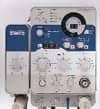| ATS Appoints New President and National Officers The American Thoracic Society (ATS) has appointed William J. Martin II MD, of Indianapolis, as president, succeeding Jeffrey Glassroth, MD. Martin was sworn in for a 1-year term on May 9, during ATS 2000 Toronto, the 96th International Conference. He is the president and CEO of Indiana University Health Care representing the 650 faculty physicians of the Indiana University School of Medicine.
Thomas R. Martin, MD, of Seattle was appointed as vice president, and will serve as president from 2002 to 2003. Martin is professor of medicine and director of the University of Washington pulmonary/critical care research training program. He has had leadership roles in the ATS, the American Physiological Society, and the European Respiratory Society. Homer A. Boushey, Jr, MD, of San Francisco was elected by the ATS membership this year to the position of secretary-treasurer. He will serve as president in 2003-2004. He is professor of medicine at the University of California, San Francisco where he directs an Asthma Clinical Research Center supported in part by a grant from the National Heart, Lung, and Blood Institute. Glassroth, the immediate past president, is the George R. and Elaine Love Professor and chair of the Department of Medicine at the University of Wisconsin at Madison. He has previously served as chair of the ATS Assembly on Microbiology, Tuberculosis, and Pulmonary Infections, and chair of the ATS Postgraduate Education and Program and Budget Committees. www.thoracic.org |
Spirometry May Be Key to Early COPD Detection
A recent paper released by the National Lung Health Education Program (NLHEP) reveals that spirometry could be the key to early detection of chronic obstructive pulmonary disease (COPD) in smokers. According to recent National Heart, Lung, and Blood Institute statistics, there are an estimated 15 million Americans with undiagnosed COPD. NLHEP chairman Thomas L. Petty, MD, says that spirometry can quickly detect COPD in its early stages. He adds that abnormal spirometry readings can also be indicative of heart disease, cancer, and stroke—the three most common causes of death in the United States.
On the basis of a large survey of health of Americans, Petty and his colleagues estimate that more than one fourth of American smokers aged 45 and over with any respiratory symptoms are developing COPD as evidenced by airway obstruction on spirometry testing. They also found that approximately 10% of men and 14% of women who smoke but have no respiratory symptoms do have abnormal spirometry readings.
NLHEP’s principal recommendation is that primary care providers perform spirometry tests in their offices for all smoking patients aged 45 and over. Anyone with shortness of breath, chronic cough, excess mucus, or wheezing should also be tested. Considerable attention should then be given to smokers with airway obstruction detected by the spirometry test and every effort should be made to help them stop smoking. “COPD that has developed in a susceptible smoker is usually diagnosed after more than two-thirds of lung function has been permanently lost,” Petty says. “By that time the patient complains of shortness of breath during even moderate activity.”
NLHEP has also provided specifications for a new type of spirometer for detecting COPD in smokers, which is designed to be less expensive, faster, and easier to use than current models used for asthma. The accuracy of these new office spirometers will be validated by clinical trials in primary care settings before they are offered for sale later this year. In the meantime, doctors can use current models of diagnostic quality spirometers to detect COPD in their smoking patients and intervene before the disease progresses to the point of becoming disabling. www.nlhep.org.
Proper Reevaluation of Continuous Oxygen Therapy Could Save Millions
A recent study revealed that improper reevaluation of patients—primarily smokers over 45—with chronic obstruction pulmonary disease (COPD) on continuous oxygen therapy (COT) unnecessarily may be costing Americans $153 million per year. This is because either patients are not reevaluated in a timely manner or the reevaluation is not performed accurately.
The study considered 57 COPD patients who were prescribed home oxygen therapy; of the 55 who returned to the clinic, only 19 were appropriately reevaluated according to the guidelines established by the Third Oxygen Consensus Conference. The conference recommended that patients receiving COT be reevaluated 1 to 3 months after continuous oxygen therapy is initiated when the patient is medically unstable. The Medicare system currently allows a full year to pass before reevaluation. Of those 19, 11 (58%) were discontinued from COT. Researchers say that up to 60% of the remaining patients could have potentially been discontinued from COT if they had been given appropriate reevaluations.
The study report indicates that close to 800,000 patients receive long-term oxygen therapy in the United States yearly, at a cost of $1.8 billion. Recent Medicare statistics reveal that in 1992, more than 168,000 beneficiaries were new home oxygen users. On the basis of the study’s findings, approximately 32,000 of those COPD patients remained unnecessarily on COT during that year. Proper reevaluation of such patients could have saved anywhere from $106 to $153 million. The researchers suggest that Medicare restrict the initial prescription of COT to 3 months in a first step to save money.
The study also found that the rate of appropriate reevaluation was significantly higher among pulmonary physicians than among primary care physicians. This suggests that referring patients using COT to a pulmonary specialist is the best course of action to ensure proper reevaluation of their conditions. www.aart.org.
 RT Magazine EAB Member Retires RT Magazine EAB Member RetiresJulien Roy, RRT, a member of RT’s Editorial Advisory Board, has retired from his position at Halifax Medical Center, Daytona Beach, Fla, as of April 28, 2000. He was sent to the Cleveland Clinic for a second evaluation on his declining heart function. His ejection fraction is still very low—20%. Extensive damage to the left side, which now is affecting his right side with enlargement and high pressures, suggests that a heart transplant will be performed in the near future. He is also waiting to have a dual ventricular pacer implanted. Roy will be doing some work with pulmonary disease management to keep himself occupied and will stay involved with the American Association for Respiratory Care and the American Association of Cardiovascular and Pulmonary Rehabilitation, nationally and at the state level. VSRC Holds Annual Fall Symposium |
NETT Yields Valuable Information Regarding Emphysema Patients at ATS
The National Emphysema Treatment Trial (NETT), designed to evaluate the benefits and risks of lung volume reduction surgery in patients with emphysema, is already yielding valuable information on the natural history, pathophysiology, and treatment of severe emphysema. Some of this information was made available at the American Thoracic Society (ATS) 96th International Conference that was held in Toronto on May 5-10.
“NETT has already characterized and followed in detail the largest group of severe emphysema patients ever, and we have only begun to mine the information in the baseline data that could impact the lives of emphysema patients,” comments Alfred P. Fishman, MD, chairman of the NETT Steering Committee.
Participants enrolled in NETT are characterized as to the type and distribution of emphysema, exercise ability, quality of life, and associated heart effects, among other variables. NETT also examines how these characteristics change with 6 to 10 weeks of medical treatment given to all participants before being randomly assigned to receive either surgery with medical treatment or medical treatment alone.
Important findings on several characteristics of emphysema patients are reflected in the following key abstracts that were presented at the ATS conference:
• Predictors of Improved Health-Related Quality of Life (QOL) Following Pulmonary Rehabilitation in the NETT. Reilly J, Moy M, Kaplan R, Diaz P, Benditt J, Criner G, Lee S, Boston. Findings: Patients with the poorest QOL at baseline experienced the most significant improvements in QOL with rehabilitation.
• Pulmonary Rehabilitation Improves Exercise Capacity and Dyspnea in the NETT. Make B, Tolliver R, Christensen P, Karla S, MacIntyre N, Ries A. National Jewish Medical & Research Center, Denver. Findings: Of the first 490 trial participants with severe emphysema, pulmonary rehabilitation resulted in improved exercise capacity, improved functional capacity, and decreased shortness of breath.
• Measurement of Health-Related QOL in the NETT. Kaplan RM, Reilly J, Mohsenifar Z. La Jolla, Calif. Findings: Preliminary evidence suggests significant improvements in QOL following the rehabilitation phase of NETT.
• Correlates of Resting Energy O2 Consumption (RO2) in Severe Emphysema. Marzouk K, Cohen R, Levine M, Berkoski P, O’Donnell CP, Polotsky VY, Scharf SM. New Hyde Park, NY, Baltimore. Findings: Examining the relationships between resting energy needs and body mass and lung function indicated resting energy use in emphysema patients was more than double that of normal patients. This was probably due to the necessity to overcome abnormal lung function.
• Similar Patient Outcomes After Rehabilitation at a NETT Clinical Center and its Satellite Rehabilitation Programs. Meldrum MK, Martinez FJ, Jain A, Strawderman R, Christensen PJ. Ann Arbor, Mich. Findings: Preliminary results indicate that standardized pulmonary rehabilitation can be delivered by a clinical center and trained satellite programs with similar patient outcomes.
The trial, funded and overseen by the National Heart, Lung, and Blood Institute along with Medicare, is taking place at 19 primary research sites and more than 300 satellite sites across the country. Information on NETT is available at (800) 314-2597; www.nettstudy.org; www.emphysemastudy.org. Additional information regarding these abstracts is available on the ATS Web site, www.thoracic.org.


 Adam Wanner, MD, of Miami was installed as president-elect, and will serve as president from 2001 to 2002. Wanner is the director of the pulmonary and critical care medicine division with an endowed chair at the University of Miami where he is also vice chairman for research in the Department of Medicine. He directs a large pulmonary/critical care fellowship program and heads a productive asthma research program.
Adam Wanner, MD, of Miami was installed as president-elect, and will serve as president from 2001 to 2002. Wanner is the director of the pulmonary and critical care medicine division with an endowed chair at the University of Miami where he is also vice chairman for research in the Department of Medicine. He directs a large pulmonary/critical care fellowship program and heads a productive asthma research program. 







